
Salix purpurea, the purple willow, purpleosier willow, or purple osier, is a species of willow native to most of Europe and western Asia north to the British Isles, Poland, and the Baltic States.

Salix viminalis, the basket willow, common osier or osier, is a species of willow native to Europe, Western Asia, and the Himalayas.

Salix pentandra, the bay willow, is a species of willow native to northern Europe and northern Asia. The scientific name refers to the male flowers having five stamens. The English name derives from the resemblance of the leaves to those of the bay laurel; other common names include bay-leaved willow and laurel willow. Its glossy leaves make it more decorative than many other willows, so it is often planted as an ornamental tree.

Salix nigra, the black willow, is a species of willow native to eastern North America, from New Brunswick and southern Ontario west to Minnesota, and south to northern Florida and Texas.
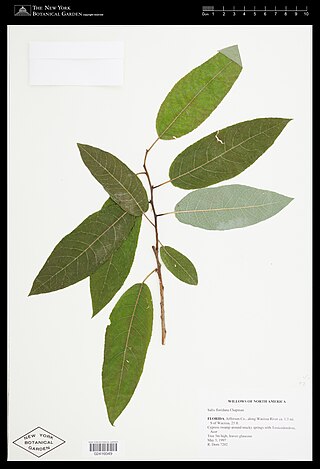
Salix floridana, the Florida willow, is a species of willow in the family Salicaceae. It is native to the southeastern United States in northern Florida and southwestern Georgia.

Salix triandra, with the common names almond willow, almond-leaved willow or black maul willow, is a species of willow native to Europe and Western and Central Asia. It is found from south-eastern England east to Lake Baikal, and south to Spain and the Mediterranean east to the Caucasus, and the Alborz Mountains. It usually grows in riparian habitats, on river and stream banks, and in wetlands.

Salix delnortensis is a species of willow known by the common name Del Norte willow.
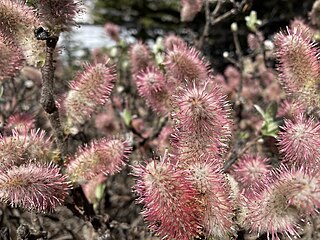
Salix barrattiana is a species of flowering plant in the willow family known by the common name Barratt's willow. It is native to North America, where it is distributed across Alaska and western Canada, with also a few populations in Montana and Wyoming. These disjunct populations are probably relics from a time when the climate was colder. The southernmost population is technically in Wyoming, but it is located at the Montana state line and it is limited to one clone of all-staminate plants within an area of 100 square meters (1,100 sq ft) in a high-elevation habitat.
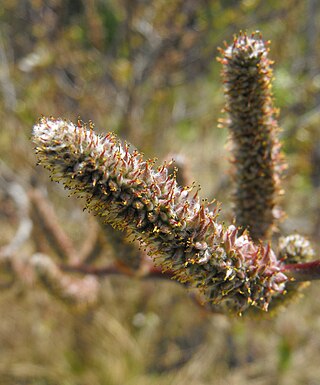
Salix breweri is a species of willow known by the common name Brewer's willow. It is endemic to California, where it can be found in the serpentine soils of the Coast Ranges in and around the San Francisco Bay Area. It is a riparian shrub growing one to four meters in height. The yellowish or reddish brown stems are lightly hairy in texture, the small twigs coated in velvety fibers. The leaves are generally lance-shaped, smooth-edged or gently toothed, and partially rolled under along the edges. The leaves are hairy, with the lower surfaces often quite woolly. Mature leaves may be 14 centimeters long or more. The inflorescence is a catkin which develops before the plant produces leaves. The catkins are up to 5 or 6 centimeters long, the female ones lengthening further as the fruits develop.
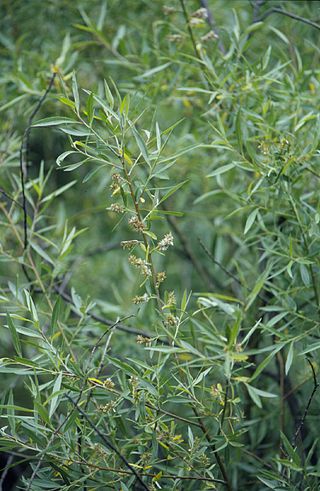
Salix geyeriana is a species of willow known by the common names Geyer's willow, Geyer willow and silver willow. The type specimen was collected by the botanist Karl Andreas Geyer, for whom it was named. Its conspicuous, yellow flowers begin to bloom as early as March, to as late as the end of June.

Salix melanopsis is a plant species known by the common name dusky willow. It is native to western North America from British Columbia and Alberta to California and Colorado, where it grows in many types of moist and wet habitat, such as riverbanks and subalpine mountain meadows, on rocky and silty substrates.
Salix orestera is a species of willow known by the common name Sierra willow, or gray-leafed Sierra willow. It is native to the Sierra Nevada of California and western Nevada, where it grows in moist areas in high mountain subalpine and alpine climates. It can also be found in Oregon.
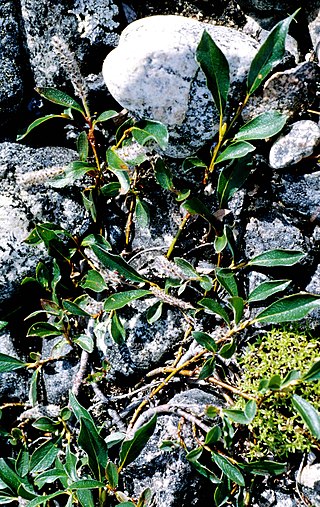
Salix planifolia is a species of willow known by the common names planeleaf willow, diamondleaf willow, and tea-leafed willow. It is native to northern and western North America, including most of Canada and the western United States. It grows in many types of arctic and alpine habitats in the north, and mountainous areas in the southern part of its range.

Salix arbusculoides is a species of flowering plant in the willow family known by the common name little tree willow. It is native to northern North America, where its distribution extends across Alaska and most of Canada.
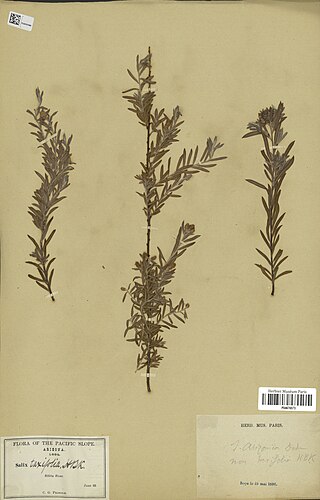
Salix arizonica is a species of willow known by the common name Arizona willow. It is native to the southwestern United States, where it occurs in Arizona, Colorado, New Mexico, and Utah.
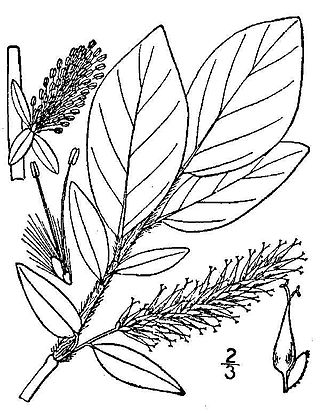
Salix barclayi, or Barclay's willow, is a species of willow native to North America, found primarily in the Northwestern area of the United States and Canada. It grows near lakes and streams at elevation. It is a shrub, that can grow up to 2.5 m. (8 ft.) tall and tends to be slender. Leaves are elliptic to obovate, 2–6 cm long and 1–2.5 cm wide. Leaves are hairy when young, with midrib hairs lasting into maturity. Catkins are on short, leafy peduncles. Staminate catkins are 3 cm long with 2 stamens, while pistillate catkins are 2.5–5 cm long and glabrous.

Salix eleagnos the bitter willow, olive willow, hoary willow, rosemary willow, or elaeagnus willow, is a species of flowering plant in the family Salicaceae, native to central and southern Europe and south west Asia. Growing to 3 m (10 ft) tall by 5 m (16 ft) broad, it is an erect bushy deciduous shrub with narrow grey-green leaves up to 20 cm (8 in) long, which turn yellow in autumn (fall). The green catkins, 3–6 cm (1–2 in) long, appear with the leaves in spring, male catkins having yellow anthers.

Salix humboldtiana, called Humboldt's willow, is a tree species of willow native to North and South America, growing along watercourses. Some authorities consider it a synonym of Salix chilensis, which Molina described in 1782. Willdenow described Salix humboldtiana in 1805.

Salix eriocephala, known as heart-leaved willow or Missouri River willow, is a species of willow native to a large portion of the temperate United States and Canada.

Salix erioclada is a species from the genus of willows (Salix) and grows as a shrub or small tree. The leaf blades have a length of about 5 centimeters. The natural range of the species is in China.



















